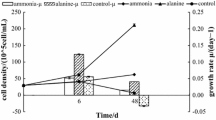Abstract
Incorporation of organic compounds into cell protein by the obligate chemolithotrophs Nitrosomonas spec., Nitrosococcus oceanus, Nitrosococcus mobilis, Nitrosovibrio tenuis, Nitrosolobus spec., and Nitrosopira spec. was studied. In the presence of ammonia as energy source organic substrates were supplied. Distribution of 14C into cell amino acids arising from 14C-labelled glucose, Na-pyruvate, and Na-acetate was investigated. While carbon from glucose was distributed unrestricted, carbon from pyruvate preferably entered into the amino acids of the pyruvate and glutamate family and from acetate mainly into leucine and the glutamate family. Among the strains examined, slight differences were observed, but all should be included under group A of the scheme of Smith and Hoare (1977).
Similar content being viewed by others
References
Campbell A. E., Helebust J. A. and Watson S. W. 1966. Reductive pentose phosphate cycle in Nitrosocystis oceanus. — J. Bacteriol. 91: 1178–1185.
Davey J. F., Whittenbury R. and Wilkinson J. F. 1972. The distribution in the methylobacteria of some key enzymes concerned with intermediary metabolism. — Arch. Mikrobiol. 87: 359–366.
Hooper A. B. 1969. Biochemical basis of obligate autotrophy in Nitrosomonas europaea. — J. Bacteriol. 97: 776–779.
Johnson E. J. and Abraham S. 1969a. Enzymes of intermediary carbohydrate metabolism in the obligate autotrophs, Thiobacillus thioparus and Thiobacillus neapolitanus. — J. Bacteriol. 100: 962–968.
Johnson E. J. and Abraham S. 1969b. Assimilation and metabolism of exogenous organic compounds by the strict autotrophs Thiobacillus thioparus and Thiobacillus neapolitanus. — J. Bacteriol. 97: 1128–1208.
Kaiser F. E., Gehrke C. W., Zumwalt R. W. and Kuo K. C. 1974. Amino acid analysis —Hydrolysis, ion-exchange cleanup, derivatization and quantitation by gas-liquid chromatography. — J. Chromatogr. 94: 113–133.
Kelly D. P., 1970. Metabolism of organic acids by Thiobacillus neapolitanus. — Arch. Mikrobiol. 73: 177–192.
Koops H.-P., Harms H. and Wehrmann H. 1976. Isolation of a moderate halophilic ammonia-oxidizing bacterium, Nitrosococcus mobilis nov. sp. — Arch. Microbiol. 107: 277–282.
Krümmel, A. 1978. Vergleichende Untersuchungen zum Einfluß organischer C-Verbindungen auf das Wachstum, das Fettsäuremuster und die Feinstruktur ammoniakoxidierender Bakterien. —Thesis, Univ. Hamburg.
Matin A. 1978. Organic nutrition of chemolithotrophic bacteria. — Annu. Rev. Microbiol. 32: 433–468.
Peeters T. L., Ziu M. S. and Aleem M. J. H. 1970. The tricarboxylic acid cycle in Thiobacillus denitrificans and Thiobacillus A2. — J. Gen. Microbiol. 64: 29–35.
Samoilov P. M., Aaranova N. A., Vorob'eva L. I. and Fedulova I. E. 1968. Influence of carbon source on amino acid formation and protein synthesis in Mycobacterium luteum. — Microbiologiya 37: 264–268.
Smith A. J., London J. and Stanier R. Y. 1967. Biochemical basis of obligate autotrophy in blue-green algae and thiobacilli. — J. Bacteriol. 94: 972–983.
Smith A. J. and Hoare D. S. 1977. Specialist phototrophs, lithotrophs, and methylotrophs: Unity among a diversity of procaryotes? — Bacteriol. Rev. 41: 419–448.
Suzuki I. and Werkman C. H. 1958. Chemoautotrophic carbon dioxide fixation by extracts of Thiobacillus thiooxidans. I. Formation of oxalacetic acid. — Arch. Biochem. Biophys. 76: 103–111.
Taylor B. F. and Hoare D. S. 1971. Thiobacillus denitrificans as an obligate chemolithotroph. II. Cell suspension and enzymic studies. — Arch. Mikrobiol. 80: 262–276.
Wallace W., Knowles S. E. and Nicholas D. J. D. 1970. Intermediary metabolism of carbon compounds by nitrifying bacteria. — Arch. Mikrobiol. 70: 26–42.
Watson S. W., Graham L. B., Remsen C. C. and Valois F. W. 1971. A lobular ammonia oxidizing bacterium, Nitrosolobus multiformis nov. gen. nov. sp. — Arch. Mikrobiol. 76: 183–203.
Williams P. J. LeB. and Watson S. W. 1968. Autotrophy in Nitrosocystis oceanus. — J. Bacteriol. 96: 1640–1648.
Author information
Authors and Affiliations
Rights and permissions
About this article
Cite this article
Martiny, H., Koops, HP. Incorporation of organic compounds into cell protein by lithotrophic, ammonia-oxidizing bacteria. Antonie van Leeuwenhoek 48, 327–336 (1982). https://doi.org/10.1007/BF00418286
Received:
Issue Date:
DOI: https://doi.org/10.1007/BF00418286




